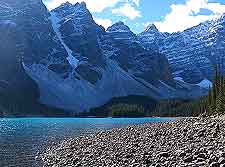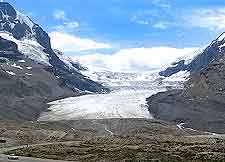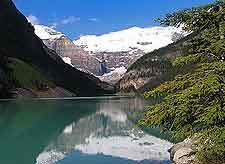Lake Louise History Facts and Timeline
(Lake Louise, Alberta, Canada)

Lake Louise, one of Canada's leading alpine resorts, can trace its roots directly to the development of the first Canadian transcontinental railroad line.
Over time, this sublime slice of the Rockies has evolved into a Mecca for mountaineering and is now a favoured hideaway for royalty and celebrities alike. With the modern advent of ski resorts, Lake Louise has become a popular base for outdoor recreation all year round, with everything centered around the majestic Fairmont Chateau, which is perched right on the edge of the milky emerald-colored lake.
The Era of Rail Travel
When the Canadian Pacific Railway first worked its way through the towering Rocky Mountains in the late 1800s, a railroad horse wrangler named Thomas Wilson happened to meet up with a group of local Stoney Indians at Kicking Horse Pass. They told him of the Lake of Little Fishes, a magical body of water tucked deep into the high mountain valley just above the planned railway line. They took him to the lake in August of 1882, which he immediately recognised as something truly special, christening it Emerald Lake due to its color.
In 1884, the name of the lake was changed to Lake Louise in honour of Princess Louise Caroline Alberta, the daughter of England's Queen Victoria and even more importantly, the wife of the then Governor General of Canada, the Marquis of Lorne. Recognising the lake as a premier destination for mountaineers and a major promotion for the railroad, the Canadian Pacific Railway built the first modest log cabin on the shores in 1890 and began receiving adventurous guests.

The Birthplace of Canadian Mountaineering
The general manager of the railway, Cornelius Van Horne, first envisioned the lodge at Lake Louise as a 'hotel for outdoor adventurers and alpinists'. The late 1800s was an era of British fascination in exploration, especially of wild, dangerous mountains.
An ill-fated alpine expedition in 1896 to the summit of Mount Lefroy resulted in the death of one Phillip Abbot, with the nearby divide now named the 'Abbot Pass' in his honor. As a result, the railway brought in two professional Swiss alpine guides to lead hotel guests up the mountains in the area. The rest is history, as they say. Over the proceeding years, hundreds of first ascents were made to newly named peaks and the intrepid Swiss guides forged miles of alpine trails that are still used today.
A Chateau is Born
By 1913, the history of Lake Louise was being shaped by the ever-growing chateau on its shore and the iconic people who visited. King Edward VIII was one of the first royal guests, followed over the years by Queen Elizabeth II, Prince Rainier of Monaco and many others. Movie stars like Alfred Hitchcock, Douglas Fairbanks and Marilyn Monroe also put the chateau into the spotlight, helping to propel this world-class outdoor environment into one of Canada's premier summer holiday destinations.

A Modern Masterpiece
By 1982, the Chateau Lake Louise had evolved into a year-round resort, taking advantage of the incredible skiing around
Banff at Mount Norquay, Lake Louise and Sunshine Village in winter, and the outstanding hiking trails in summer.
Between 1986 and 1990, US$65 million was spent upgrading the hotel into the magnificent building guests enjoy today. Its new Mount Temple Wing is a soaring masterpiece of architecture, ensuring a place for Lake Louise in the history books of sublime travel destinations for decades to come.
 Lake Louise, one of Canada's leading alpine resorts, can trace its roots directly to the development of the first Canadian transcontinental railroad line.
Lake Louise, one of Canada's leading alpine resorts, can trace its roots directly to the development of the first Canadian transcontinental railroad line.
